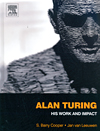- About MAA
- Membership
- MAA Publications
- Periodicals
- Blogs
- MAA Book Series
- MAA Press (an imprint of the AMS)
- MAA Notes
- MAA Reviews
- Mathematical Communication
- Information for Libraries
- Author Resources
- Advertise with MAA
- Meetings
- Competitions
- Programs
- Communities
- MAA Sections
- SIGMAA
- MAA Connect
- Students
- MAA Awards
- Awards Booklets
- Writing Awards
- Teaching Awards
- Service Awards
- Research Awards
- Lecture Awards
- Putnam Competition Individual and Team Winners
- D. E. Shaw Group AMC 8 Awards & Certificates
- Maryam Mirzakhani AMC 10 A Awards & Certificates
- Two Sigma AMC 10 B Awards & Certificates
- Jane Street AMC 12 A Awards & Certificates
- Akamai AMC 12 B Awards & Certificates
- High School Teachers
- News
You are here
Alan Turing: His Work and Impact

Publisher:
Elsevier
Publication Date:
2013
Number of Pages:
914
Format:
Hardcover
Price:
74.95
ISBN:
9780123869807
Category:
Monograph
The Basic Library List Committee recommends this book for acquisition by undergraduate mathematics libraries.
[Reviewed by , on ]
Charles Ashbacher
01/2/2014
Although he only lived 41 years, Alan Turing had a significant effect on the world. Through his work in decoding the German military message in World War II, he arguably did more to keep Great Britain from losing the war in the dark time after the withdrawal at Dunkirk than anyone other than Winston Churchill. His concept of the simple Turing Machine not only solved one of the famous Hilbert problems, it put forward a theoretical model for computers that can still be used to study the power of the fastest supercomputers.
This thick volume is a collection of Turing’s most significant papers along with commentary by people that appreciated and furthered his ideas. What will astound even the people that know the work of Turing is the breadth of his interests and depth of his competence. The list of contributors for the commentaries is impressive, including Turing biographer Andrew Hodges, logicians from Martin Davis to Gregory Chaitin, number theorists such as Andrew Odlyzko, computer scientists from Lenore Blum to Stephen Wolfram, philosophers and biologists whose name I probably should recognize as well. Included here are some of the classic works on machine game playing, computational biology, and artificial intelligence. What’s more, they can still be used to educate, especially with the added commentary.
As early as the late 1940s Turing was putting forward serious ideas about the future of computing, even though at the time computers were relatively incapable hulks. Although the Turing test for artificial intelligence is no longer considered proof positive of machine intelligence, there is no question that any intelligent machine would have to be able to pass it.
In some ways a person that thought decades ahead of his time, Alan Turing died much too young. Whenever the topic is the social cost of prejudice, there is no stronger argument against it than citing the case of Turing, a man that was most likely hounded to suicide for his being gay at a time when it was a criminal offense. If you doubt the size of our loss, simply scan the subject lines in the table of contents of this book.
Charles Ashbacher splits his time between consulting with industry in projects involving math and computers, teaching college classes and co-editing The Journal of Recreational Mathematics. In his spare time, he reads about these things and helps his daughter in her lawn care business.
Part I: How Do We Compute? What Can We Prove?
1.Alan Mathison Turing
2.On Computable Numbers, with an Application to the Entscheidungsproblem
3.On Computable Numbers, with an Application to the Entscheidungsproblem - correction
4.Review of Turing 1936-7
5.Computability and λ-definability
6.The p-function in λ-K-conversion
7.Systems of Logic based on Ordinals
8.A Formal Theorem in Church’s Theory of Types
9.The Use of Dots as Brackets in Church’s System
10.Practical Forms of Type Theory
11.The Reform of Mathematical Notation
Part II: Hiding and Unhiding Information: Cryptology, Complexity and Number Theory.
1.On the Gaussian Error Function
2.A Method for the Calculation of the Zeta-function
3.Some Calculations of the Riemann Zeta-function
4.On a Theorem of Littlewood
5.The Word Problem in Semi-groups with Cancellation
6.Solvable and Unsolvable Problems
7.The Word Problem in Compact Groups
8.On Permutation Groups
9.Rounding-off Errors in Matrix Processes
10.A Note on Normal Numbers
11.Turing’s treatise on the Enigma (Prof’s Book)
Report by Turing on U. S. Navy cryptanalytic work and their machinery, November 1942
Speech System ’Delilah’ - report on progress, 6 June 1944
Checking a Large Routine; An early program proof by Alan Turing
Programmers’ Handbook for the Manchester electronic computer
Local Programming Methods and Conventions
Part III: Building a Brain: Intelligent Machines, Practice and Theory.
1.Lecture to the London Mathematical Society
2.Intelligent Machinery
3.Computing Machinery and Intelligence
4.Chess; Solvable and Unsolvable Problems
5.Intelligent Machinery: A heretical theory
Can digital computers think?
Can automatic calculating machines be said to think?
6.Some Remarks on the Undecidability Results
Part IV: The Mathematics of Emergence: The Mysteries of Morphogenesis.
1.The Chemical Basis of Morphogenesis
2.A Diffusion Reaction Theory of Morphogenesis in Plants
3.Morphogen Theory of Phyllotaxis
Geometrical and Descriptive Phyllotaxis
Chemical Theory of Morphogenesis
A Solution of the Morphogenetical Equations for the Case of Spherical Symmetry
4.Outline of the Development of the Daisy
- Log in to post comments




